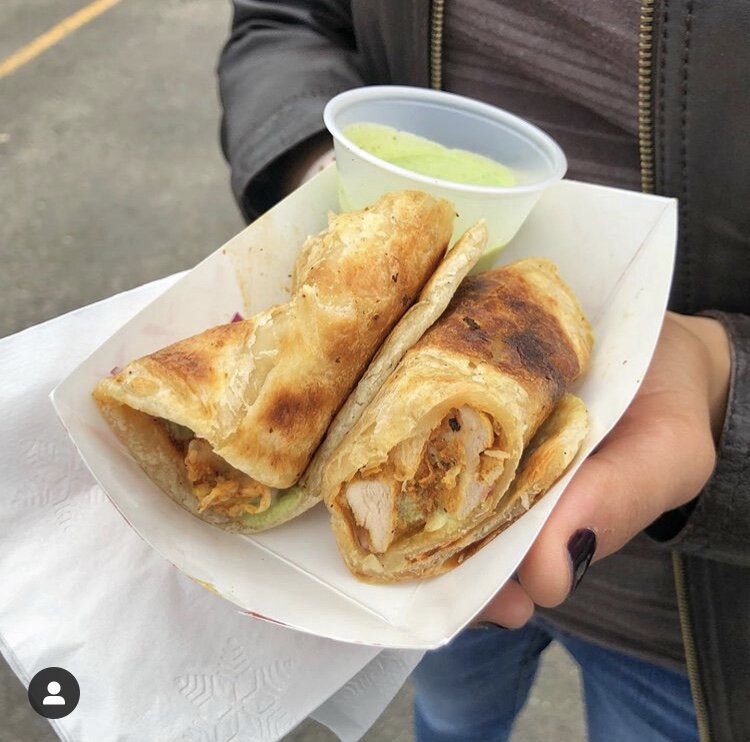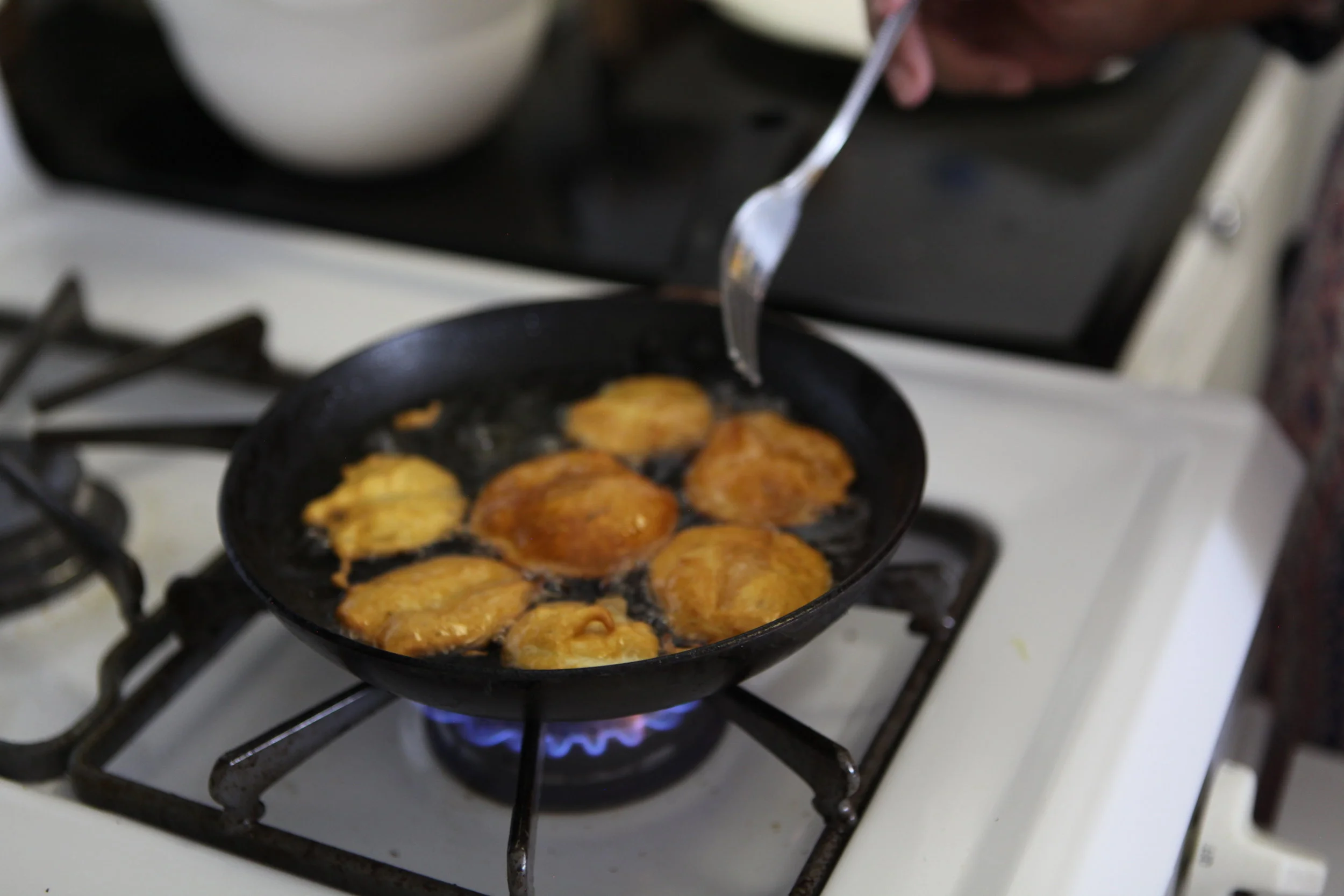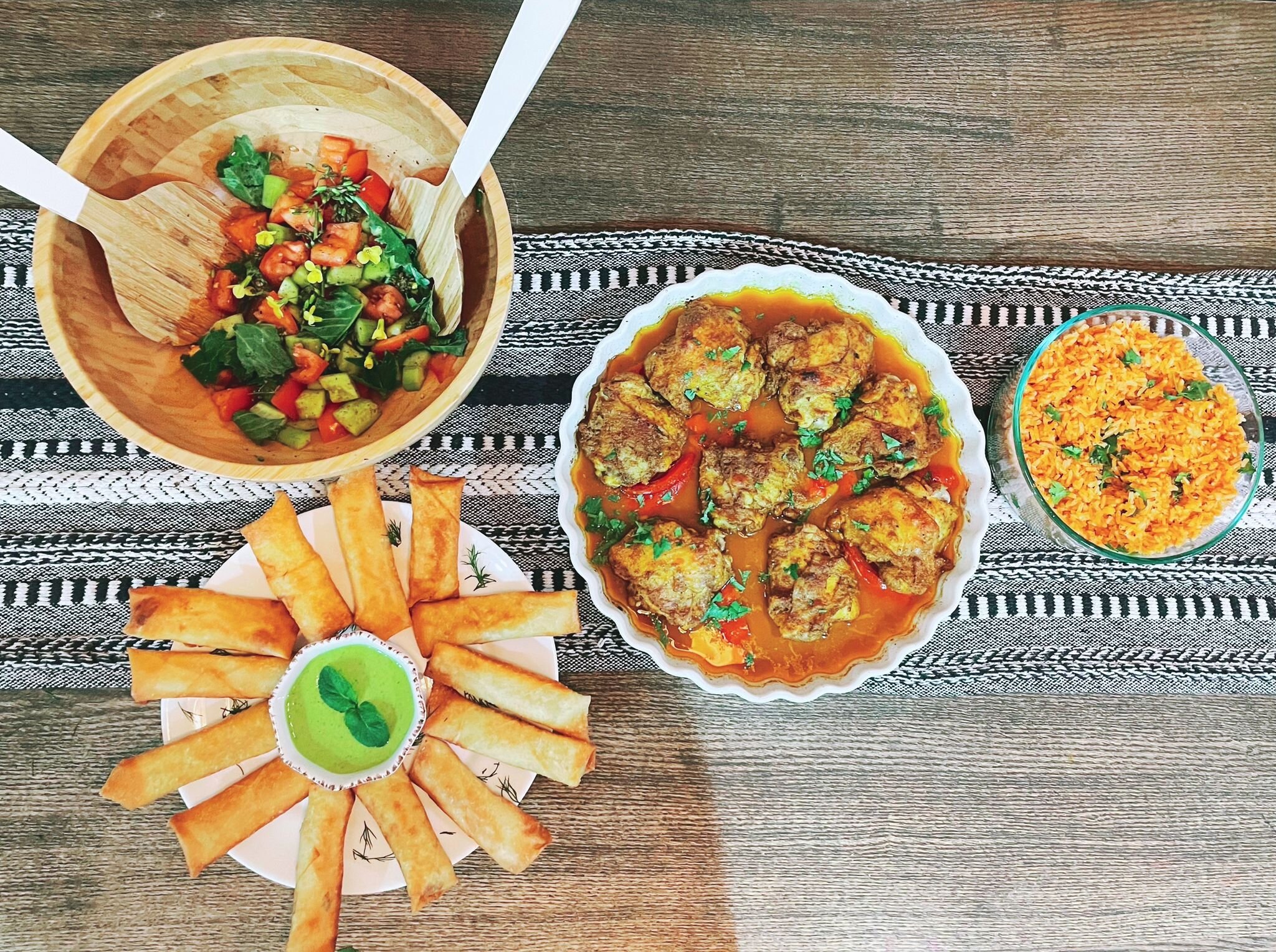Tandoori Chicken Kati Rolls (Pakistan)

Maeda was destined to love food. “When I was born, my parents couldn’t figure out what to name me, so my dad went around different mosques in Brooklyn, where I was born, asking “What should I name my daughter? I want something unique, not something very common.” And someone said, “What about Maeda from Sura Maeda?” It’s a chapter in the Quran. The guy said it’s like “feast” with an abundance of food, or a dastarkhan, which is a cloth that we typically put on the floor to eat. And it just symbolizes—you know—abundance, food, happiness. So my dad was in love with the name, came back to the hospital and told my mom, “This is what I want to name my daughter.”
She was raised in Queens, immersed in the Pakistani culture of her parents at home (“my mom never made chicken nuggets or mac and cheese”) and expanding her palette through the Food Network. “ I started watching it a really young age and started making stuff and testing recipes. And that's I kind of you know, how I decided I wanted to become a chef. I just couldn't tell my parents because I knew they were going to get a little worried”.
Eventually, Maeda managed to convince them that it was a career worth pursuing: she trained at the Culinary Institute of America and then started working in the kitchen of a high-end restaurant. “It was the same thing over and over that I kept cooking for rich people that I didn't see. I was just in the kitchen and it was really repetitive, and I wanted something more out of it” she explains. “I’ve always believed in giving back to the community and I wanted to use the skills that I learned in culinary school to do that. And I didn't want to work in a restaurant anymore, not because I didn't like the cooking aspect, but I just didn't get the satisfaction that I wanted”.
“I started volunteering at a nonprofit in Harlem called Harlem Children's Zone. It's like an after school program for teenagers, middle school children, pre-schoolers. And one of their programs was teaching kids about nutrition and I thought that, hey, I know the cooking aspect. I can introduce nutritious food and teach them how to cook by adding flavor. So that was my strength and I knew how to cook food that was healthy, but also delicious because I know for myself I'm not going to eat anything that doesn't taste good, even if it’s healthy. So I would make like healthy versions of pizza and fried chicken. And that's what really piqued my interest in nutrition.”
Following this experience, Maeda enrolled in Columbia University’s nutrition program, and is now a clinical dietitian at Elmhurst Hospital in Queens, where she helps determine the diet of patients in the ICU. While she loves her job, she didn’t want to give up on cooking entirely and still wanted to use food to give back to the community. “Zakaat- charity – is one of the pillars of our religion” she explains. “I grew up assisting my mom as she was constantly making Pakistani food -anything from samosas to Biryani- and selling it at the mosque to raise funds for our school”.
With some happy customers in front of The PakiStand
As if she was not busy enough, Maeda started The PakiStand in Summer 2019, a pop-up food stand she works on during her free time, and from which all profits derived go to support childhood education programs in Pakistan. “It’s kind of like a mix of who I am, a mix of Pakistani food and fusion foods”. The PakiStand can usually be found on summer Saturday evenings at the Queens International Night Market, a large open-air market featuring independent vendors and small-scale cultural performances, all celebrating the rich cultural diversity and heritage of NYC and Queens. For now, though, in the midst of the Covid-pandemic, Maeda assists her family by packing and distributing boxes of pantry stuff like cereal, rice, lentils and flour out of their garage to local families in need, who have lost their jobs or family members. “Taking care of those in need is also what Ramadan is about. And appreciating that you are only fasting for 30 days, but there are people around the world who go to bed hungry every single day”.
Maeda’s favorite childhood Ramadan memory is all about the strength of community. “All our neighbors were from Pakistan, so it was like a big cultural thing… we would share whatever we made and give it to our neighbors. There was always this floating plate that everyone had— my mom had her signature plate design, and let’s say she made biryani: She would put biryani on that plate, cover it with paper towel, and say to me, “OK, go give it to them.” And that plate would come back to us later in the week with other foods that they’d made, just to return the plate, you know? You can’t give an empty plate back to the people that gave you food!”.
Maeda with her family on a previous Eid
This year though, as everyone has been forced into social isolation, Ramadan is a little different. “I miss going to the mosque. We go to the mosque a lot, especially during Ramadan and there's something called Taraweeh Prayer - special prayers during Ramadan. So that's not happening. So a lot of the imams are doing the virtual ones through laptops and Facebook Live and all that, which is not the same thing cause there's just like… there's a special feeling of getting ready and going to the mosque and, you know, putting your nice clothes on”. Maeda also misses the iftari parties which are usually an opportunity to catch up with friends at this time of year. If there is one silver lining to all this though, is that quarantine has brought her siblings back home from across the US. “Last year, it was just me and my parents, but this year, we are all here together”.
Tandoori Chicken Kati Rolls
Maeda’s Kati Rolls recipe is inspired from a trip to Pakistan in 2011. It’s considered more modern cuisine – not something her mom would have made for her growing up. “Paratha is traditional Pakistani and so is chicken tikka, but I think the merge of them is maybe taking from different cultures. I would describe it to someone who doesn’t know, as a sort of chicken tikka burrito”. They are now widely popular as street food in Pakistan and increasingly in cafes and small restaurants. Typically they’re made of tandoori chicken or grilled beef, topped with sliced onions and green chutney and wrapped in flaky paratha bread. Maeda’s recipe doesn’t call for the traditional clay tandoor oven, which creates a beautiful char with heat going up to 1,000°F (540°C). She’s adapted the recipe to use in a conventional oven or on a charcoal grill.
Ingredients for 5 servings
For the tandoori chicken
8 ounces (225 g) skinless, boneless chicken thighs, cut into 1-inch (2 .5 cm) cubes
1⁄2 cup (115 g) nonfat Greek yogurt
Juice of 1 lemon
1 tablespoon olive oil
1 or 2 garlic cloves, grated
1⁄2-inch (13 mm) piece peeled fresh ginger, grated
1⁄2 teaspoon ground cumin
1⁄2 teaspoon ground turmeric
1⁄2 teaspoon Indian red chili powder (lal mirch)
1⁄2 teaspoon sweet paprika
1⁄4 teaspoon cayenne pepper
For the green chutney
1 bunch cilantro, leaves and stems
1⁄2 cup (120 ml) lemon juice
5 green Thai chilis, stems removed
1⁄4 teaspoon salt
1⁄4 teaspoon ground black pepper
Optional: add some plain yoghurt for a creamier consistency and you can also add a bit of mint
5 frozen parathas (or you could make them from scratch, if you have the patience!)
1 medium red onion, thinly sliced
Directions
1. To make the tandoori chicken, combine all of the ingredients in a large bowl, cover, and marinate in the refrigerator for at least 12 hours and up to 24 hours.
2. Preheat the oven to 350°F (180°C) or prepare a charcoal grill for a smokier flavor. Place the chicken on a baking sheet and bake for 20 to 25 minutes, or grill directly on the grill, until cooked through.
3. To make the green chutney, blend the cilantro, lemon juice, chilis, salt, and pepper in a blender or food processor on high until smooth, about 2 minutes, and set aside. If the mixture is too dry, add a splash of water while blending.
4. To make the kati rolls, thaw and heat the parathas in a dry skillet over medium heat until crispy, about 4 to 5 minutes each. Transfer each to a plate and place 4 or 5 pieces of the chicken, some of the red onion, and a drizzle of green chutney on the center. Fold in the sides, wrap up tightly like a burrito, and enjoy.
*The italic segments of Maeda’s story and this recipe are excerpted from The World Eats Here: Amazing Food and the Inspiring People Who Make It at New York’s Queens Night Market, © 2020 by John Wang and Storm Garner. Reprinted by permission of The Experiment.







